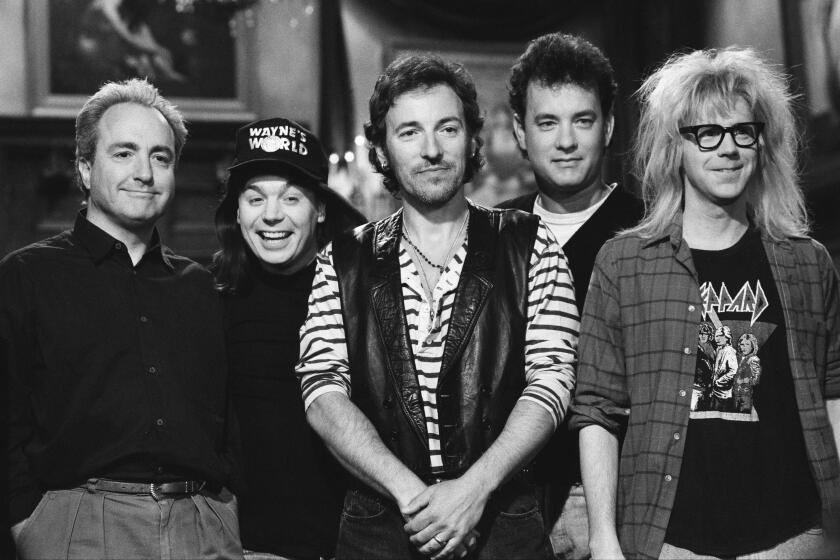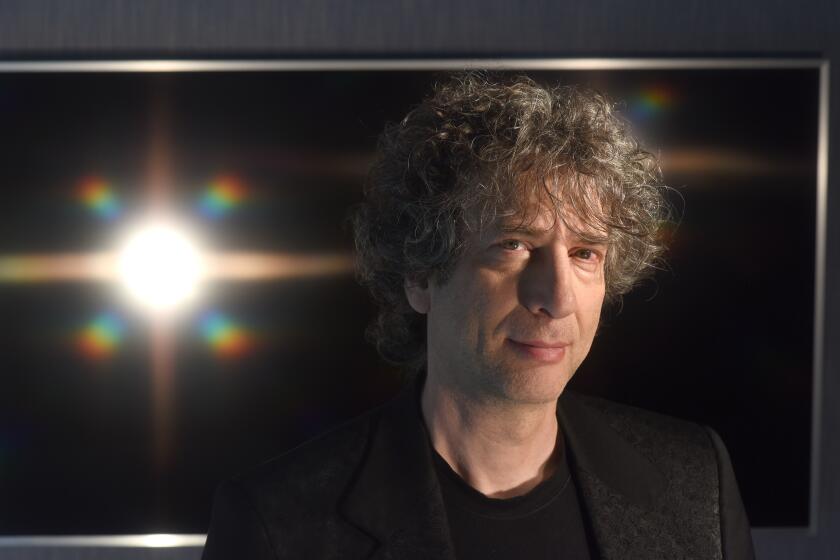ACHILLES IN THE QUANTUM UNIVERSE: The Definitive History of Infinity.<i> By Richard Morris</i> . <i> Henry Holt: 224 pp., $25</i> : THE INVENTION OF INFINITY: Mathematics and Art in the Renaissance.<i> By J. V. Field</i> . <i> Oxford University Press: 264 pp., $35</i>
- Share via
Since ancient times, mathematicians, scientists, philosophers and theologians have struggled with the dark mysteries of infinity. Our universe seems to be of finite size, expanding at an unknown rate ever since the Big Bang, but is there an infinite space into which it is expanding? Time also seems to have started with the bang, but was there some sort of super time before then? And if our universe has enough matter to halt the expansion and send the cosmos backward toward a Big Crunch, will time continue to march on?
For Immanuel Kant, the infinities of time and space were contradictory “antinomies.” It is difficult to imagine space extending forever, but it is just as hard to suppose it stops, because that will lead you to ask: “What’s outside the boundary?” It is hard to imagine time without beginning and end but equally hard to suppose otherwise.
Cosmologists today are speculating, as did the 16th century Italian philosopher Giordano Bruno and others before him, that there may be an infinity of isolated universes, each with its own set of laws. Only a tiny subset of these universes allows life to arise. As someone has said, a universe is something that happens now and then. Time, someone else said, is what keeps everything from happening at once.
Infinity also extends inward. Is there an ultimate particle, or does matter have infinite levels of structure like a set of Russian dolls? Science fiction writers have long played with the concept of infinite universes. H.G. Wells wrote a story in which our cosmos is an atom in a ring worn by a gigantic hand. Other writers have turned our atoms into other universes. Cyberpunk writer Rudy Rucker, in his novel “Spacetime Donuts,” introduced a wild circularity. He imagines the paradox of a person getting smaller and smaller, visiting ever tinier universes, until he finds himself back in the universe where he started without having to change his size.
Mathematicians speak of parallel lines meeting at infinity and of infinite series of fractions whose partial sums converge at infinity on a well-defined limit. Calculus rests on the summation of infinitely small quantities that German philosopher and mathematician Gottfried Wilhelm von Leibniz called infinitesimals. They were much derided by Bishop George Berkeley in the early 18th century and considered meaningless by most mathematicians until they became respectable again in what is known as nonstandard analysis.
A regular polygon turns into a circle when it has an infinity of sides. The digits of irrational numbers like pi go on endlessly without repeating a particular sequence of numbers. A revolution in mathematics occurred when German mathematician George Cantor, in papers published between 1874 and 1884, found a way to define a hierarchy of infinities.
The lowest infinity represents the number of integers, including integral fractions. The next higher one counts the real numbers. The next counts all the curves that can be drawn on a postage stamp. Cantor’s transfinite numbers, which he called alephs, are themselves infinite in number.
Theology, too, has its infinities. Does God have infinite attributes? Is God subject to time and change or does God exist in eternity, outside space and time altogether? After we die, do we suffer eternally in hell or live forever in paradise?
In recent years, a number of books have been written about infinity, including a nonfiction book by Rucker, “Infinity and the Mind.” The most recent are Richard Morris’ “Achilles in the Quantum Universe” and J. V. Field’s “The Invention of Infinity.”
Morris, author of several books about science, has done his usual excellent job of ranging over his topic in lucid, entertaining prose. He covers all the important questions and more. The Achilles of his book’s title is the Greek warrior in one of Zeno’s famous paradoxes of motion. Achilles is unable to catch a tortoise because when he reaches the spot where the turtle started, the reptile has crawled ahead a finite distance. When he goes that distance, the turtle has moved ahead by a smaller distance. The distances the turtle moves ahead keep shrinking but never vanish, so how does Achilles manage to overtake the tortoise? The two runners model dimensionless points that move along a straight line. If Achilles were to pause a minute after running each segment, he would never reach the turtle. As it is, if both go at a steady rate, the time it takes Achilles to traverse each segment also gets smaller, converging on zero, allowing him to reach the tortoise in a finite time.
Morris covers all the infinities that plague cosmology, particle physics, relativity theory and quantum mechanics. The infinities that arise in black holes are especially troublesome. In a black hole, the volume of matter becomes zero and its density goes to infinity. No one knows just what happens after that. Does the matter explode, as some cosmologists suggest, from a white hole in another universe?
Morris does his best to explain a bizarre model of the universe recently proposed by Stephen Hawking. In ordinary time, our universe has a beginning and end, but in “imaginary time” (based on imaginary numbers), the universe is infinite in both directions. As far as I can tell, no one except Hawking has taken his model seriously.
It is a credit to Morris that in writing about infinity, he draws upon understandable and entertaining analogies that have historically been used to describe infinity. For example, in explaining Cantor’s alephs, Morris introduces the notorious aleph hotel, which has an infinity of rooms numbered 1, 2, 3. . . . Every room is occupied. Can the manager accommodate the arrival of an infinity of guests? Easy. He simply moves each occupant to a room with a number twice his or her previous number. This opens up an infinity of rooms, namely all those with odd numbers. As Morris informs us, this paradox was recognized by Galileo, but it took Cantor to clarify the mathematics involved.
Morris concludes his book with the concept that “the difficulties encountered by modern physicists show us that the infinite is still as much a mystery as it was in the time of Zeno.” Both atheists and theists, he rightly maintains, can accept the now fashionable notion of a plurality of universes, perhaps even an infinity of them, exploding here and there, now and then, in some kind of super time and space. Meditating on such possibilities can arouse in one a sense of awe so intense that if it persisted more than a minute or two, one could go mad. Morris’ final sentence is a memorable quote from Pascal, as pious a theist as he was a great mathematician: “The eternal silence of these infinite spaces frightens me.”
Field’s “The Invention of Infinity,” in spite of its title, has very little in common with Morris’ book. A research fellow in art history at Birkbeck College, University of London, Field has written books about Kepler’s cosmology, the geometry of Girard Desargues and “Science in Art,” a beautiful work featuring paintings in London’s National Gallery that portray aspects of science and technology. “The Invention of Infinity” is an equally handsome volume reproducing hundreds of striking pictures, alas none in color, that relate to mathematical ideas of their time.
Although Field makes side excursions into the history of geometry and algebra, the primary focus of his book is the development of projective geometry and its application to perspective in painting. It is here that infinity comes into play as the “distance point” on the horizon at which parallel lines meet at an infinite distance from the viewer. Field’s book is essentially a detailed, erudite treatise on the collaboration of eminent Renaissance mathematicians with artists who had mastered the art of perspective.
Field reproduces and discusses numerous paintings by Italian artists, many of whom also wrote treatises on perspective. Mathematicians who contributed to perspective and the concept of infinity include Kepler, Pascal, Descartes and, above all, Desargues, the French mathematician who wrote the first great work on projective geometry in the 17th century.
Field does not neglect the conic sections curves that result when a right circular cone is sliced by a plane. If the plane is parallel to the cone’s base, the section is a circle. Tilt the cone ever so slightly and the circle’s center splits into two foci to create an ellipse, the shape a circle has when seen in perspective. As the plane assumes steeper angles, one focus moves father from the other until the plane is parallel with the cone’s side. At that point, the focus traveled to infinity and the ellipses have become a parabola with arms that are parallel when they are infinitely far from the other focus. As the cutting plane tips even more--until it is perpendicular to the cone’s base--the cross-sections turn into parabolas. Their arms meet their asymptotes at infinity.
In his last chapter, Field also refers to Pascal’s remark about his fear of infinite space. Field seems to think that Pascal is expressing not his own fears but the fears of an atheist. I believe this is a misreading of Pascal. It is Pascal’s own terror, the terror of a devout believer in God, that Pascal is describing. Here is a longer quotation from Pascal’s “Pensees,” a work saturated with wonder about the awesome mysteries of space and time:
“When I consider the short duration of my life, swallowed up in the eternity before and after, the small space which I fill, or even can see, engulfed in the infinite immensity of spaces whereof I know nothing, and which know nothing of me, I am terrified, and wonder that I am here rather than there, for there is no reason why here rather than there, or now rather than then. Who has set me here? By whose order and design have this place and time been destined for me?”
More to Read
Sign up for our Book Club newsletter
Get the latest news, events and more from the Los Angeles Times Book Club, and help us get L.A. reading and talking.
You may occasionally receive promotional content from the Los Angeles Times.







